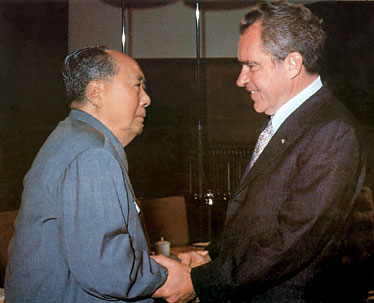This is probably
the most fluctuating period for Sino-American relations. This bilateral
relationship experienced ebbs and flows in these three decades.
In these three decades, we see three main periods of time when the United States and China cooperated strategically to meet their respective national interests in different international circumstances.
The first strategic cooperation was the opening of U.S.-China Relations due to geostrategic commonality to converge against the Soviet Union. The dramatic turnabout leading to the opening and then normalization in U.S.-China relations at the end of the 1960s and 1970s has been subject to concerns and assessments. The U.S. reconfigured the calculus of China’s position in world politics and its implications for the United States. This view highlights the importance of an apparent trend whereby U.S. leaders privately came to see China in the late 1960s as less threatening than in the past; eventually they came to view the Maoist regime as potential asset in American strategy focused increasingly on dealing with a rising and threatening Soviet Union. Despite these and other divergent views, assessments of this period and the opening in Sino-American relations find it hard not to give primacy to interpretations focused on the acute strategic necessities of both the United States and China amid circumstances of regional and international order featuring a rising and powerful Soviet Union challenging their core national interests. Similar concerns regarding national security as the U.S., the real danger of the Soviet Union military invading China, destroying its nuclear and other strategic installations, and forcing China to conform to Soviet interest moved Chinese leaders out of their self-initiated isolation.

The second
strategic cooperation was in 1980s. The new U.S. leadership in 1980s shifted
U.S. policy toward a less solicitous and accommodating stance toward China,
while giving much higher priority to U.S. relations with Japan, as well as
other U.S. allies and friends in East Asia. There was less emphasis on China’s
strategic importance to the United States in American competition with the
Soviet Union, and there was less concern among U.S. policy makers about China
possibly downgrading relations over Taiwan and other disputes. This
policy is seen to have added dimension related to a changing balance of forces
affecting Chinese security and other interests in Asian and world affairs,
which prompted heretofore demanding Chinese leaders to reduce pressures on the
United States for concessions on Taiwan and other disputed issues. The Chinese
leaders grudgingly adjusted to the new U.S stance, viewing their interests best
served by less pressure and more positive initiatives to the Reagan
administration, seen especially in their warm welcome for the U.S president on
his visit to China in 1984. Cooperative Chinese relations with the United
States were critically important to the Chinese leadership in maintaining
Chinese security in the face of continuing pressure from the Soviet Union and
in sustaining the flow of aid, investment, and trade essential to the economic
development and modernization underway in China.

Reagan's visit to China in 1984
The pattern
prevailing into the twenty-first century saw the U.S. administration and the
Chinese administration generally continue to seek closer ties, including
frequent high-level leadership meetings and various senior official dialogues,
in order to develop areas of common ground while managing differences. Both
administrations typically highlighted the many positive results from U.S.-China
cooperation and dialogue. There have included cooperation in facilitating
mutually advantageous trade and investment relations, cooperation in managing
such regional crisis and threats as the Asian economic crisis of 1997-1998, the
crisis in 1994 and again beginning in 2002 over North Korea’s nuclear weapons
program, the global war on terrorism beginning in 2001 and the ongoing economic
crisis. Under the rubric of engagement or cooperation, the U.S. administration
officials and their Chinese counterparts presided over an ever-increasing
economic interdependence between the United States and China, supplemented by
growing cultural and political contacts and developing military contacts.


